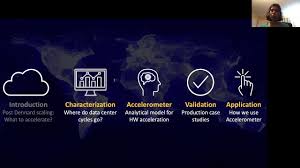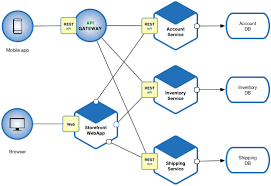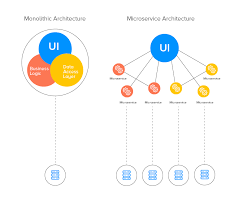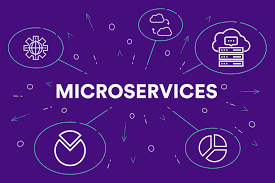Source: A microservices architecture — as the name implies — is a complex coalition of code, databases, application functions and programming logic spread across servers and platforms. Certain fundamental components of a microservices architecture bring all these entities together cohesively across a distributed system. In this article, we review five key components of microservices architecture Read More
Category: Microservices
Upgrade & Secure Your Future with DevOps, SRE, DevSecOps, MLOps!
We spend hours on Instagram and YouTube and waste money on coffee and fast food, but won’t spend 30 minutes a day learning skills to boost our careers.
Master in DevOps, SRE, DevSecOps & MLOps!
Learn from Guru Rajesh Kumar and double your salary in just one year.

Source: sdtimes.com What is a cloud-native enterprise and how does an enterprise achieve that designation? A cloud-native enterprise is one that specializes in cloud-native development, or development that is optimized for distributed infrastructures. Examples of distributed infrastructures include hybrid clouds — on-premises applications that use products and services from a multitude of sources and applications Read More

Source: enterpriseai.new The list of open source service meshes, a low-latency infrastructure layer designed to link application containers and other microservices, continues to grow as ephemeral application infrastructure scales to production. The latest offering comes from Solo.io, which this week released its “service mesh hub” to the open source community. The hub is billed as Read More

Source: techxplore.com Large-scale software services fight the efficiency battle on two fronts—efficient software that is flexible to changing consumer demands, and efficient hardware that can keep these massive services running quickly even in the face of diminishing returns from CPUs. Together, these factors determine both the quality of the user experience and the performance, cost, Read More

Source: consultancy.asia Digital and business transformation consultancy R/GA has launched an innovative ‘Lean Experience Stack’ offering in the Asia Pacific – designed to enable clients to create best-in-class digital experiences with lower investment costs, mitigated risk, and a speedier time to market. The new service will be led by R/GA’s APAC Executive Technology Director Anthony Baker, a Read More

Source: devprojournal.com Microservices architecture adoption has moved beyond use in the largest of cloud enterprises to applications of all sizes. Whether you are an early adopter – or you’re just now weighing your options — Kyle Davis, Head of Developer Advocacy, and Loris Cro, Developer Advocacy Manager at Redis Labs, authors of Redis Microservices for Dummies, share their Read More

Source: searchsecurity.techtarget.com Security professionals have probably noticed that containers, such as Docker and Rkt, as well as container orchestration — for example, Kubernetes — are gaining traction in a big way. This is because, as developers have discovered the power of microservices, they are moving away from monolithic or tightly coupled component design architectures and Read More

Source: siliconangle.com This week, throngs of cloud-native computing fans were set to descend on Amsterdam for KubeCon, the Cloud Native Computing Foundation’s conference for all things Kubernetes. Alas, like so many other conferences, the CNCF decided to postpone KubeCon. But that doesn’t mean I can’t still write about the highlights of the show in this article. Read More

Source: searchapparchitecture.techtarget.com Microservices architecture embraces small, self-contained services built, deployed and scaled independently. However, despite the allure of microservices architecture, the monolith is still relevant. Enterprises need to find a middle ground between microservices and the monolith. A good strategy is to create a hybrid microservices architecture. What is a hybrid microservices architecture? To adopt a Read More

Source: jaxenter.com Developers and their applications are the backbone of organisations across the world. But in recent years, large scale security breaches have put data protection at the forefront for product development teams. With the likes of the GDPR now in place, security must be a priority. So who is stepping up to take responsibility for the Read More

Source: rtinsights.com Netflix, Amazon, and PayPal – these well-recognized global brands fundamentally changed the way we consume entertainment, shop, and manage finances, respectively. However, without major advancements shaping the database industry over the last 40 years, these brands – synonymous with their cloud-based applications – would not exist. To be specific, today’s instant, on-demand services Read More

Source: devops.com 2nd Watch today launched a managed DevOps service based on the continuous integration/continuous deployment (CI/CD) platform from GitLab that it will operate on behalf of customers in addition to coaching them on how to adopt best DevOps practices. Stefana Muller, a senior product manager, said the 2nd Watch Managed DevOps service combines the managed and Read More

Source: jaxenter.com Borne out of many years of work in the enterprise distributed systems arena, enterprise Java went on to become a dominant force in application development. Twenty years on, Java is still standing strong towards the top of industry language rankings. This is, in no small part, a result of the level of reinvention Read More

Source: computerweekly.com Unlike digital-first organisations, traditional businesses have a wealth of enterprise applications built up over decades, many of which continue to run core business processes. In this series of articles we investigate how organisations are approaching the modernisation, replatforming and migration of legacy applications and related data services. We look at the tools and Read More

Source: thenewstack.io Service mesh technologies have emerged as a reliable way to manage observability, security and traffic management in microservices environments, typically with the use of Kubernetes for container orchestration. Specific use cases and needs for service meshes also vary. The New Stack recently completed a survey about service mesh use cases. While one third of those surveyed Read More

Source: ukauthority.com It has taken the services through a proof of concept phase and is now planning to work with Microsoft and Amazon Web Services (AWS) to make them widely available over the next six months. Chris Suter (pictured) head of digital platforms and innovation at NHSBSA, said it is also looking to further validate Read More

Source:theregister.co.uk QCon London Sam Newman, author of Building Microservices and Monolith to Microservices, told attendees at the QCon developer conference in London that “microservices should not be the default choice.” Microservices have become today’s equivalent of “nobody ever got fired for buying IBM”, a common catchphrase back in the ’80s, said Newman. “With half of all the clients I Read More

Source: containerjournal.com A platform for automating the protection containers from SentinelOne is now generally available. Fresh off raising an additional $200 million in funding, SentinelOne developed its Singularity platform to identify which communications between services should be whitelisted between endpoints and then identify and block any anomalous behavior. That approach allows SentinelOne to track, among other Read More

Source: aithority.com Microsoft Azure customers worldwide now gain access to ProcessMiner’s AI platform to take advantage of the scalability, reliability and agility of Microsoft Azure to drive application development and shape business strategies. ProcessMiner, an Artificial Intelligence platform for manufacturing, announced its platform is live in the Microsoft Commercial Marketplace. Based in Atlanta GA, ProcessMiner delivers Read More

Source: sdtimes.com The benefits of microservices over monolithic architectures are undeniable, but they don’t always come to fruition. Deven Phillips, a senior consulting engineer at Red Hat, explained while microservices accelerate delivery speeds, improve quality and reduce costs, it doesn’t happen instantly and it doesn’t provide a clear path to those results. “The major problem is that Read More

Source: techwireasia.com Both the experience economy and pace of technological change continues to move at breakneck speed. Businesses are now expected to deploy new software, services and add new code at a rate that is forcing many leaders to rethink their increasingly dated-looking architectural structures. Traditionally, if you dared to look under the hood of Read More

Source: aiuniverse.xyz Legacy systems still form the backbone of many enterprises. Yet as the demand for efficiency, scale, reliability and agility grow larger, we’ve seen an evolution in these underlying technologies to meet those needs. Let’s explore some of these technologies, their history and their evolution to see why such a change was inevitable. Because Read More

Source: jaxenter.com With the wholesale embrace of microservices in Java development, and the increasing influence of the DevOps movement, testing Java applications has never been so complex. Testing strategies developers used for monolithic applications need to be adapted to fit the realities of microservices. Plus, with microservices-based applications promising increased performance and functionality, but also Read More

Source: techrepublic.com Tech education firm O’Reilly has released its annual study of how students used its platform in the past year, and its findings deserve attention from tech decision makers. The report, which combines both usage and search data from O’Reilly’s online learning platform, paints an excellent picture of what’s trending in the tech world. By looking at Read More

Source: One of the coolest things serverless offerings do is allow you to “mix and match programming languages and frameworks like never before,” as Gartner research director Raj Bala has said. This means, as he suggested, you can write a Java application that calls Python libraries, for example, using a functions-as-a-service (serverless) platform. It may also mean, however, Read More

Source: towardsdatascience.com Microservice is a hot topic these days. But why does everyone talk about microservice? What is a monolithic architecture and what is microservices architecture? I will explain that by going through the migration process from a monolithic architecture to a microservice architecture. I will also introduce the characteristics, advantages of microservices architecture, and Read More

Source: devops.com Even experienced DevOps teams can struggle with the nuances of managing microservices in production–where a greater spotlight on network communications can introduce new operational challenges beyond those common to traditional architectures. But, by being smart about your software-based routing components, it’s possible to avoid or reduce the impact of roadblocks in the following Read More

Source: searchapparchitecture.techtarget.com Microservices architecture became popular for its ability to create applications that are flexibly scalable, resilient and independently deployable. But despite the on-paper benefits, not all organizations will gain much from microservices adoption, due to the inherent operational complexity of these architectures. That’s what makes it important to make the transition to microservices a Read More

Source: securityboulevard.com Tufin today announced the availability of Tufin SecureCloud, which combines two existing offerings to manage cybersecurity policies for both monolithic applications and emerging microservices-based application environments. Company CTO Reuven Harrison said rather than moving forward with separate products, previously known as Tufin Orca and Tufin Iris, Tufin is aiming to appease IT organizations Read More

Source: searchapparchitecture.techtarget.com In a microservices architecture, numerous small, independent services integrate as needed to form an application. As such, development teams must monitor every microservice, and the path through them, to ensure the application does what it is designed to do. This is where microservices testing tools enter the picture. To figure out how to Read More
